
Sometimes you need a break from traditional studying. But have you ever considered using games to learn English? Whether you’re preparing for the TOEFL or simply want to improve your English abilities, there are many English-learning games out there that are high quality and effective—not to mention fun!
Read on to see our picks for the best games for learning English for both groups and solo learners. But first, what makes an English-learning game good?
What Qualities Does a Good English-Learning Game Have?
Before we go over the best English-learning games, let’s look at the specific qualities that make for a top-notch language-learning game.
It’s Accurate
First things first, an English-learning game must be accurate to be effective. All grammar structures it uses should be grammatically correct, and all vocabulary words should be spelled and defined correctly.
If there are any problems or inaccuracies in the game, it’s better to avoid it. Using a game with problems like these means you’ll end up learning incorrect information! So always look for a game that’s highly reviewed and has impeccable English.
If you or someone you know is creating a game, make sure you have multiple people check and double-check that the English in it is correct. I suggest getting a native English speaker to look over any games or learning materials you make.
By the way: we have built the world's best online TOEFL course. Get online practice (TPO-sytle!) and individual grading and feedback on Speaking and Writing.
To be fair, it's possible to get a good TOEFL score studying alone. But PrepScholar is the world's most effective TOEFL course if you are worried about the TOEFL and are struggling to improve your score.
Learn how you can improve your TOEFL score by 15 points today.
It’s Effective
Games need to be more than just accurate—they must also be effective at teaching you English. Quality games will help you remember meanings of difficult words and perfect your mastery of grammar patterns through a combination of features such as word associations, images, and repetition.
An ineffective English game, on the other hand, won’t help you recall what you’ve learned or test your English skills enough.
It’s Fun
The whole point of games is that they’re supposed to be fun! A good English game will not only teach you English but also entertain you as you play it. Some of the best English games are those that make you forget you’re actually learning!
Of course, what I think is fun might not be the same as what you think is fun, so it’s important to always look for a game that aligns with your interests while also targeting the English you want to practice.
It’s Easy to Play
Finally, a good English game is one that has clear rules and is easy to learn how to play. You shouldn’t need to spend a lot of time learning the rules of the game; ideally, you’ll be able to read a description or play through the game once or twice in order to understand what you must do to win.
4 English-Learning Games for Groups and Classes
If you’re taking an English class or have a few friends who are also studying the language, here are some exciting group-based games for learning English together.

Hangman
Hangman is a classic spelling game known throughout many English-speaking countries. This game is a “one vs. group” game in which one person faces off against a group of people.
Materials: Blackboard, whiteboard, or piece of paper; chalk, marker, or pen
Summary: One person, whom we’ll call the “chooser,” selects a mystery word and writes down a blank for each letter in it. People in the group then take turns guessing a letter. For each incorrect guess, the chooser draws part of a hangman. For each correct guess, the chooser fills in the missing letters wherever they appear in the word. Play ends when either the mystery word is guessed (in which case the group wins) or when the hangman is complete (in which case the chooser wins).
How Does Hangman Teach You English?
Hangman is a great game for cementing spelling and vocabulary knowledge. You must be able to recognize how letters fit together to form English words as well as know how to spell words so that you can guess the correct letters. Finally, you must know a wide range of vocabulary in order to correctly guess the mystery word.
How to Play Hangman
1. One player selects a mystery word (the other players will guess the word). For example, Helga picks the word “rabbit.” “Rabbit” has six letters in it, so she draws six blanks. She also draws a pole for the hangman and a box for keeping track of any incorrect letters guessed. Here’s an example:

2. One by one, the other plays guess letters. If the letter is in the mystery word, the chooser must write that letter wherever it appears in the word (it might appear more than once). If the letter is not in the word, the chooser writes it in the box and then draws one part of the hangman (most people start with the head). Let’s say Phoebe guesses the letter “H,” Nadine guesses “L,” Harold guesses “E,” and Arnold guesses “B.” Helga writes the incorrect letters in the box and the correct letters in the word; she also draws three parts of the hangman:
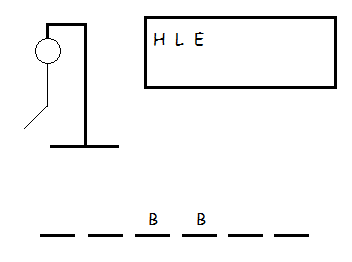
3. Play continues until the mystery word is guessed OR the hangman is complete. If someone in the group guesses the correct word, they win! If the group doesn’t guess the word, however, the chooser (in the example above, Helga) wins. A complete hangman usually has a head, a body, two arms, two legs, and a face.
Tips for Playing Hangman
- Guess common letters first! Most native English speakers start by guessing some of the most common letters in words, which include all vowels (a, e, i, o, u) and the consonants “r,” “s,” and “t.”
- For a slightly easier game, use categories. For example, let’s say before Helga chose the word “rabbit,” she told the group she’d be choosing a word from the category “Animals.” This makes it easier to figure out which letters and words you should guess.
- For a more difficult hangman game, use phrases instead of single words. Be sure to clearly indicate where spaces between words are (I find it’s helpful to insert long vertical lines between words).
- If you’re the chooser, write down the word you’ve picked on a (hidden) piece of paper. You can use this to ensure you’ve written down the correct number of blanks and are spelling the word right.
- Consider ahead of time what a complete hangman looks like. You might want to talk it over with your group to determine how much you can draw until a hangman is complete. Most people draw the following body parts:
- A head
- A body
- Two legs
- Two arms
- Two eyes
- A nose
- A mouth
However, you may also draw the following:
- Two ears
- Two hands
- Two feet
- Two eyebrows
- Hair

Fruits Basket
Fruits Basket is a fun and interactive game similar to musical chairs. This game focuses on speaking and listening to English words and phrases. It’s a group game, so there are no winners or losers!
Materials: Chairs (one less than the total number of people playing), arranged in a circle and facing in; cards with pictures or English words on them (optional)
Summary: Everyone except one person sits down in a chair (the person standing in the middle of the chair circle is the “stander”). The stander then says an English phrase or vocabulary word. Anyone sitting who meets the requirement of the phrase or word must get up and sit down in a different chair. At this time, the stander, too, tries to sit down in an empty chair. Whoever is left without a chair is the new stander and must now say a new phrase or word to make people stand up again.
How Does Fruits Basket Teach You English?
Fruits Basket can either focus on grammar or vocabulary. It teaches you not only to think quickly but also to communicate with others through a combination of speaking and listening. As a result, you can hone your pronunciation to further increase your confidence in your speaking skills.
This game is also easily adaptable, so if you’ve learned a certain grammar structure you want to practice more, you can tweak the game to work with that particular pattern.
Want to improve your TOEFL score? We have the world's leading TOEFL course.
Built by world-class instructors from Harvard and MIT, the course offers individual review, interactive lessons, and realistic online praactice, at an affordable price! It's the fastest way to get your target TOEFL score.How to Play Fruits Basket
1. Decide whether you’ll be practicing grammar or vocabulary. Once you’ve decided, follow the instructions below to prepare your game.
- For Grammar: You don’t need to prepare anything special ahead of time. Simply decide on the grammar pattern you want to practice. The easiest pattern to use is “People who have/like/want ~.” Anyone who fits the sentence must then stand up and move. You can use any number of grammar patterns as long as you can apply them to the people in the group. For example, if you want to practice the conditional “if” form, you could say, “If you like cats, stand up!” Then, anyone who likes cats must get up and move.
- For Vocabulary: You’ll need to prepare ahead of time if you plan to practice specific words. Start by making cards containing certain vocabulary words (or pictures of words). Make at least two cards for each word. For example, if you’re studying food, make at least two cards with apples on them, two with oranges, etc. Next, attach these cards to pieces of string to make them into necklaces people can wear around their necks. Assign one card to each person playing. If the stander says the word you’re wearing, you must move to a new seat.
2. Get out several chairs so that there is one less than the number of people playing. For example, if ten people are playing, get out nine chairs. Arrange these chairs in a circle so that all chairs are facing inward. If you’re practicing vocabulary words, make sure everyone is wearing a card around his/her neck.
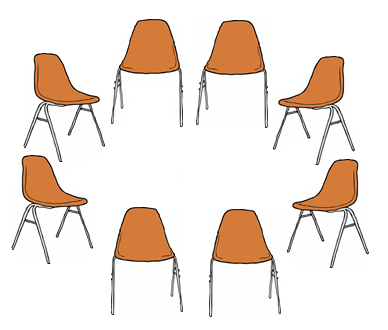
3. Choose one person to be the “stander.” Everyone else sits in a chair. Remember that the stander changes often, so you won’t be stuck in the role if you’re chosen to be it first!
4. The stander says a grammar structure or vocabulary word. Anyone sitting who meets the requirement must stand up and move quickly to an open chair. For example, if you’re practicing the grammar form “People who have ~,” you could say, “People who have a driver’s license.” Then, anyone who has a driver’s license must stand and find a new seat. On the other hand, if you’re practicing vocabulary words, you could say, “Apple!” and anyone who is wearing an apple must find a new seat.
5. The game ends whenever you want it to! There are no winners or losers. Continue playing until you want to stop.
Tips for Playing Fruits Basket
- To make the game more difficult, make it illegal to sit down in the chair next to you. This prevents people who are sitting near each other from switching chairs too fast.
- Say “Fruits Basket” to get everyone to move. If you’re having trouble finding a seat or getting people to move, the phrase “Fruits Basket” forces everyone to stand up and choose a new chair.

Battleship
This popular, strategic board game uses the setting of war and can be tweaked to help English-language learners practice grammar and communication. Battleship is a pair game, so only two people can play together.
Materials: Battleship game sheet (see below for tips on how to make one); pen or pencil
Summary: Players get into pairs and fill out their Battleship sheets by placing five ships on various parts of a grid. Once they’ve “hidden” their ships, players take turns attacking each other by using their grids to guess where the other person’s ships are. Whoever “sinks” (finds) all of his/her opponent’s ships first wins.
How Does Battleship Teach You English?
This game is a great tool for practicing grammar patterns while honing your reading, speaking, and listening skills. To sink your opponent’s ships, you must be able to read English and put together sentences. To make an attack, you need to pronounce English clearly. Finally, you must understand what your opponent is saying in order to figure out what square in your grid he/she is trying to attack.
How to Play Battleship
1. Make a Battleship worksheet with two grids on it. One grid will be for hiding your ships, and the other will be for guessing where your opponent’s ships are. Here’s an example of a worksheet I made back when I taught English in Japan. On this sheet are parts of sentences listed horizontally and vertically. Each vertical sentence part can match with any horizontal part, and vice versa. Your grids can be however big you want them to be, though I suggest making them no bigger than 8×8 (what I’ve done on my own worksheet).
2. Choose an opponent and begin “hiding” your ships on your grid. You’ll usually have five ships of varying lengths. To hide a ship, mark As, Bs, Cs, etc., on your grid (horizontally or vertically but not diagonally!). Don’t let your opponent see your grid. Here’s an example:
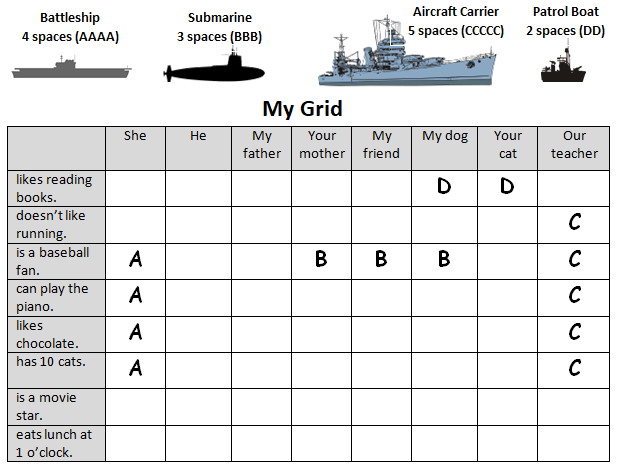
3. Take turns guessing squares on your opponent’s grid. You’ll use the second grid on your sheet to guess where your opponent has hidden his/her ships. To guess a square, make an English sentence by combining one phrase from the top row and one phrase from the column on the left.
4. Mark your opponent’s grid with Xs and Os. If the square you’ve chosen hits one of your opponent’s ships, your opponent must say, “Hit!” You can then mark an “X” on your opponent’s grid to indicate you’ve made a hit. If the square you’ve chosen doesn’t hit a ship, your opponent must say, “Miss!” You can then mark an “O” on the grid to show that you did not hit a ship (and instead hit water). For example:
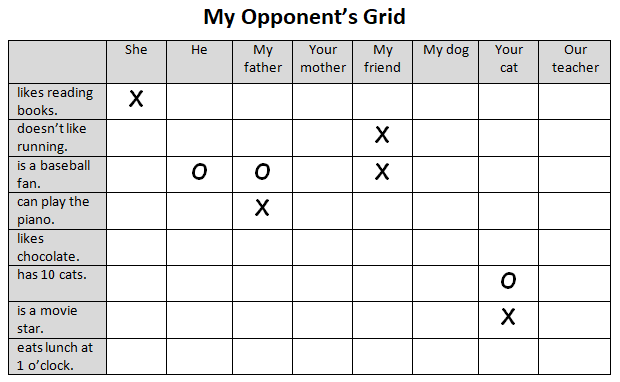
5. If you’ve hit all parts of a ship, your opponent must say, “Sink!” Now you know you’ve sunk one of your opponent’s ships.
6. Mark any areas your opponent has attacked on your own grid with Xs (or a different color). This lets you keep track of where your opponent has attacked and how many ships you still have remaining. Here’s an example:
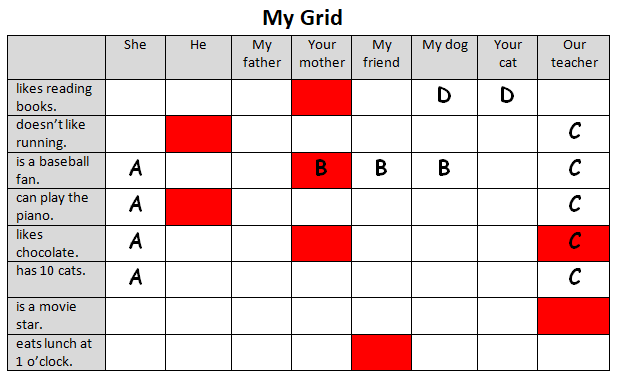
7. Play ends when one player has sunk all of his/her opponent’s ships.
Tips for Playing Battleship
- Spread out your ships on your grid. This makes it less likely for your opponent to find all of your ships right away.
- If you make a hit, guess squares adjacent to the square you hit. This increases your likelihood of finding the rest of your opponent’s ship and sinking it.
- Do not overlap any ships. This is against the rules!
- When making a Battleship worksheet, you don’t need to use five ships. I recommend having at least three ships, though my worksheet above uses four.

20 Questions
A popular word game, 20 Questions can be played anytime, anywhere! All you need to do is think of a word (like Hangman) and you’re ready to play. You’ll need at least two players, though you can play with as many people as you want.
Materials: None!
Summary: The setup for this game is similar to Hangman. One person will be the “chooser” and think of a mystery word. This word could be a person, animal, thing, place, etc. The others in the group may then ask up to 20 yes-or-no questions to figure out what the word is. If the group guesses correctly, they win! But if they use up their 20 questions and don’t guess correctly, the chooser wins!
Want to improve your TOEFL score by 15 points?
Registration is now open for our best TOEFL course. We guarantee your money back if you don't improve your TOEFL score by 15 points or more.
PrepScholar TOEFL is online and it features thousands of practice questions and 1-on-1 Speaking and Writing review and feedback.
How Does 20 Questions Teach You English?
20 Questions requires no visuals or materials, so it’s 100 percent focused on active English communication—that is, speaking and listening. You must be able to clearly ask questions in English and keep track of what’s been asked in order to successfully solve the mystery.
How to Play 20 Questions
1. Decide who will be the “chooser.” This person will secretly come up with a word or phrase. You may use categories to narrow down what words you can choose (see tip #1 below).
2. Once the chooser has thought of a word, people in the group can take turns asking questions. All questions must use a yes-or-no format; this means that the chooser may only answer with either yes or no. Those asking questions typically use the following grammar structures:
- “Is it ~?”
- “Can it ~?”
- “Does it ~?”
3. Play ends when either the word has been guessed (in which case the group wins), or when 20 questions have been asked (in which case the chooser wins).
Tips for Playing 20 Questions
- Consider using categories to narrow down the types of words and phrases the chooser can pick. For example, if you were to play with the category “Characters,” the chooser must think of a well-known character from a book, TV show, movie, play, etc.
- Start broad and then get specific. Most people who play this game start with basic questions about color, size, etc., before they ask more specific questions about things like relationships, abilities, likes/dislikes, etc.
- You may use pen and paper to keep track of how many questions have been asked. This is especially useful in big groups of people.

3 English-Learning Game Websites for Solo Learners
Now that we’ve gone over a few games you can play with others, let’s look at some English-language games you can play by yourself.
Unfortunately, most solo games don’t have speaking or listening components, so you’ll need to supplement these games with real-life English practice (ideally, with native English speakers). That said, online English games can be excellent tools for quickly honing your skills and for warming up before study sessions.
Here are our picks for the top websites offering online English games for solo learners. And the best part is, they’re all free!
ESL Games World Grammar Games
This popular website offers numerous flash ESL games for both children and adults. However, its grammar section offers the best stockpile of games geared toward intermediate and adult English-language learners.
You can study a range of grammar structures and parts of speech on this site, including past and present tense, conjunctions (e.g., and, but, so), and prepositions (e.g., in, of, to, on). Many of the games come in multiple versions to address a variety of grammar patterns.
My favorite games are the basketball and soccer ones as well as the “Fling the Teacher” game, in which you must answer questions about prepositions to prove you no longer need a teacher. Many of these games are two-player as well, which is a nice touch if you’ve got a buddy you want to study with.
There are a couple of drawbacks, though. For one, some of the games immediately end when you get just one question wrong. It’s frustrating to have to constantly start the game over to progress to the next question. Another problem is that some of the games say “Continue” when they should read “Restart” or “Play Again.” While “Continue” implies there are more words or levels left, a lot of the time the game simply repeats.
Games to Learn English
Another free website, Games to Learn English offers several high-quality language-learning games for honing both your grammar and vocabulary knowledge.
With all games, you can choose specific categories to study. For example, with vocabulary-focused games, you can choose to study jobs, body parts, animals, etc. With grammar-based games, you can work with sentence patterns such as the conditional “if,” the future tense (“going to ~”), etc.
Many games work well for adult learners, and I particularly enjoyed the grammar-centered ones. In “Fast Phrases” you create sentences to match the images shown, while in “Bubbles” you connect words to form sentences. “Hangman” is another solid option if you want to improve your vocabulary and spelling.
Some of the games even let you upload your own images and words to practice with. In short, you get to not only play games but also customize what you learn in them!
One big con, however, is that much of the vocabulary is fairly basic. In addition, some of the games are too similar to one another, giving the website a slightly repetitive feeling.
Free Rice
Though not as outwardly fun as the other websites on this list, Free Rice is a great way to practice upper-level English vocabulary and grammar—all while making a positive impact on the world!
There are two modes you can play for English: English vocabulary and English grammar. In vocabulary mode, you must match a word with its synonym (a word with the same meaning). In grammar mode, you must choose one of two sentences, only one of which is grammatically correct.
And the best part? For every correct answer, Free Rice donates 10 grains of rice via the World Food Programme to help end world hunger.
Another benefit of this website is that you can choose your level. There are five levels for English grammar and 60 for vocabulary. (Quick note: I looked at level 60 for vocabulary mode, and there are many words even I, a native English speaker, didn’t know!)
The only major con is that Free Rice isn’t as flashy and interactive as the other resources on this list, so if you’d prefer more visual stimulation and images, opt for a different resource.

Conclusion: How English-Learning Games Can Help You
When studying English, it’s important to have a routine and access to high-quality materials. But sometimes studying can get boring—which is why it’s perfectly OK (and even encouraged!) to use a few games to learn English.
Ultimately, though, you need to make sure that the games you’re using are high quality. Good games will teach accurate English, be effective, entertain you, and be easy to play.
Above, we gave you four English-learning games for groups and three English websites for solo studying. As you use these and other games to learn English, remember the key point: while games for learning English can be helpful, you shouldn’t rely on them to teach you English from scratch. Games are best used as supplementary resources to cement material you’ve already studied using textbooks, flashcards, and other resources.
With that said, go ahead and explore the games we’ve compiled for you as well as any other high-quality ones you find along the way. Most importantly, have fun learning English!
What’s Next?
Need more help learning English? Get some guidance on setting your English-language goals with our article on how to learn English (coming soon).
Struggling with English vocabulary? Check out our top methods for learning English vocabulary fast and effectively (coming soon)!
Are you planning to take the TOEFL? Get expert tips on how to prepare for the TOEFL, and check out our collection of the best TOEFL strategies you need to know!
Ready to improve your TOEFL score by 15 points?
Download our best TOEFL Strategy eBook (valued at $14.49) for FREE! Learn the top 5 strategies you must know to improve your TOEFL score. Download it for free now:
